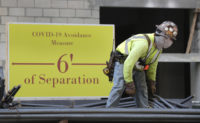Recession's Realities, the New Normal and How To Win Work
Experts agree it’s going to be a new world once the U.S. emerges from the current economic slump. But what will that look like?

The past once was a good predictor of the future. No more. Patterns and preferences of all sorts are shifting in economics, housing, infrastructure, culture and demographics. The question when trying to predict the future is which of those patterns are “cyclical recessionary impacts” and which are “underlying seismic shifts” that will continue indefinitely, said James Chung, president of Reach Advisors, Slingerlands, N.Y.
Chung and two panels, one featuring construction professionals and the other owners, explored future scenarios at the Society for Marketing Professional Services Foundation Think Tank on Oct. 11-12 in Washington, D.C. On the downside, bids and rates are staying low, funding is lagging, and work is scarce. However, quality seems to be improving, joint-venture partnerships are flourishing, and innovation is more welcome than ever, panelists said.
Industry professionals are adapting to their new reality in pricing, partnerships and planning. “We’re changing our rate structure. It could be a generation before we see rates going back up,” said Doug Wignall, international director of health care for HDR Architecture Inc., Omaha, Neb. “We’ve expanded the meaning of the word ‘client’ ” to include partners such as design firms and subcontractors, said John Tarpey, CEO, North region, for Balfour Beatty Construction, Fairfax, Va.
“People will listen to their peers, so if a job is going well, offer to co-promote it,” said Jim McDonnell, program director, American Association of State Highway and Transportation Officials. Jim Slack Jr., president of Slack & Co. Contracting Inc., Houston, said, “Our window of looking ahead was six to nine months a year ago. Now we’re looking two years out, and we’re looking for bigger projects.”
Owners are seeing more teams proposing to them, which brings challenges and rewards. “We’ve seen some exceptional collaboration,” said Michael Ensch, chief, operations and regulatory community of practice for the U.S. Army Corps of Engineers. He suggested getting to know prospective partners through industry organizations so it will be easier to work together.
Sometimes construction gets ahead of design on short-fused projects, and it requires extraordinary teamwork to succeed, said Peter Arn, vice president of capital improvements for LifeBridge Health, Baltimore. He recommends mentoring by a larger firm to help small firms win work, which, in LifeBridge’s experience, decreases risk.
The lagging economy is bringing unexpected benefits to owners. Steve Thweatt, assistant vice president of planning, design and construction for Emory University, Atlanta, said, “The quality of work and attention to service has improved. There was room for that; it’s a welcome change. When things get busy again, it will be pressure again for fast, fast, fast.”
Despite the high jobless rate, recruitment remains difficult for all. People in positions that once were subject to relocation now are reluctant to pick up and move. For example, they may have a spouse with a career or a son with a prized quarterback slot on the high school football team who don’t want to be uprooted, said Thomas Scarangello, chairman of structural engineer Thornton Tomasetti. David L. Richter, president and COO of Hill International, added, “Shanghai, Dubai, Mumbai or goodbye” is the conversation he has had with prospective employees.
Everyone wants to know what owners want, and the client panel gave suggestions (see box). They also marveled at mistakes they see over and over. Les Shepherd, chief architect for U.S. General Services Administration, said, “I’m surprised at the architectural firms that don’t do their homework. They will marry up with a contractor that we haven’t had good experience with, and they move to the bottom of the list.” He added, “We do call references. I can’t tell you how many times they say, ‘I can’t believe they listed us as a reference. Let me tell you how this project went!’ ” Follow the rules of the solicitation in detail, he added, citing one firm that was ahead of the other contenders but lost by bringing 10 people to an interview when the limit was five.
| • Visit the site of the project ahead of time, even if you have to travel. |
| • Put together a team in which the different cultures mesh. (This strategy is more important than compatible computer platforms.) |
| • Make certain that every team member you propose will be on the project—and stay. |
| • Don’t go around, behind or above your official point(s) of contact to get a foot in the door or insider information. Such a move only makes it harder for them to choose you. |
| • Establish a rapport. Owners say again and again that chemistry is a key factor in selecting a winner. |
| • Don’t over-Google the people on the owner’s team. They consider it creepy if you know too much about them. |
| • Treat the administrative staff and the rank- and-file people well. They have more influence than you think. |




